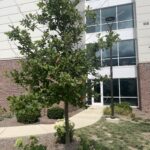Flower Notes:
White (Not ornamentally important; spring)
Foliage Notes:
Green (Lustrous leathery foliage; summer); Multi-Colored (Almost fluorescent fall foliage changing from yellow to orange to scarlet to purple)
Fruit Notes:
Blue (Small blue-black fruits (drupes) up to 0.5" diameter; eaten by birds and mammals; summer)
Soil Notes:
Prefers moist, well-drained, acid soils; does not tolerate high pH
Diagnostic Characteristics:
Leaves are alternate, ovate to elliptic, 4-7.5" long and wide, entire margin, but sometimes remotely toothed, glossy (waxy) upper and dull on the lower surface. Leaves form on slow growing spurs. Three distinct vascular bundles in leaf scars. Buds are vari-colored. Chambered pith.
 Indiana Native
Indiana Native 